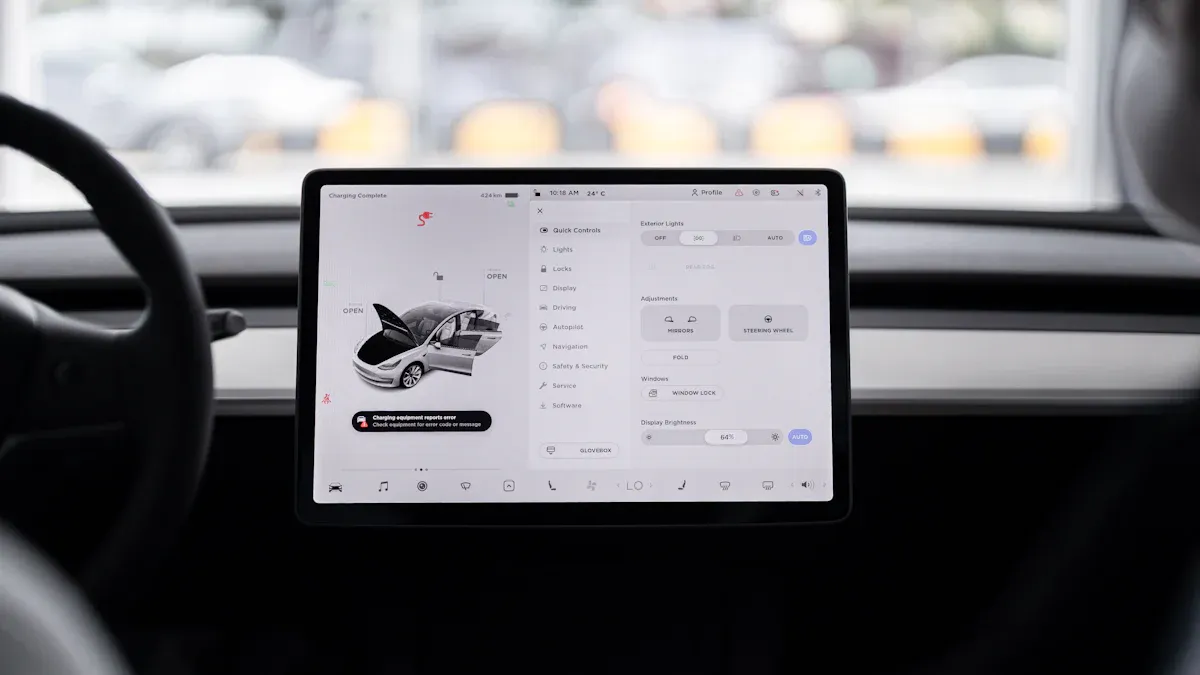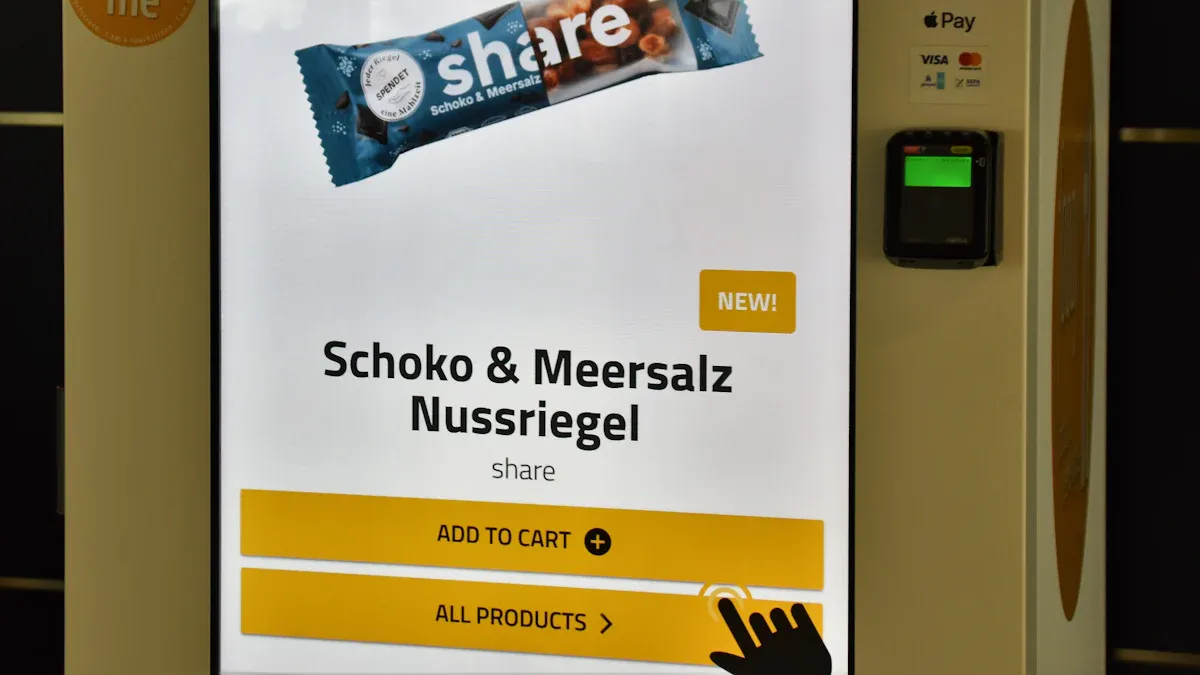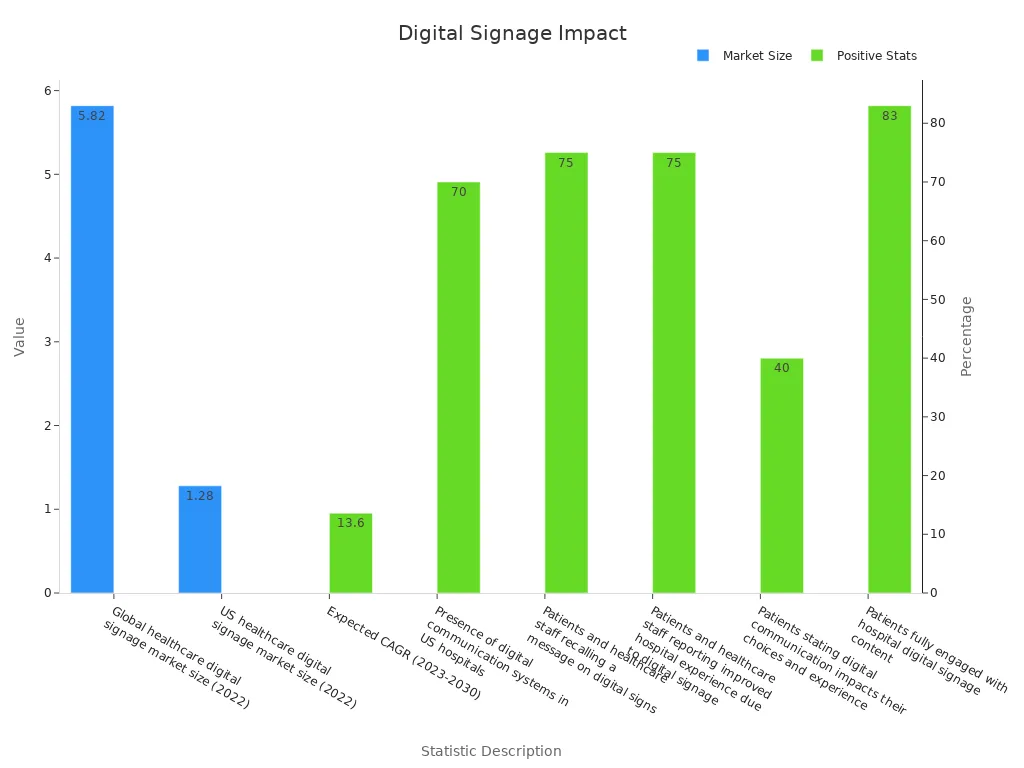Small Digital Signage: Features, Applications, and Implementation Strategies for 2025

Small digital signage refers to compact display screens that deliver dynamic content in real time. Businesses increasingly adopt these digital signage solutions due to cost efficiency, instant updates, and measurable impact.
Small digital signage displays now make up 60% of the market share, especially in retail and hospitality.
Digital signage usage has grown over 15% each year since 2015, with 31% sales increases reported in retail stores.
Trend | Impact |
|---|---|
AI Personalization | AI adapts content to the viewer, boosting engagement and sales. |
Mobile Integration | QR codes and smartphones create interactive, touchless experiences for customers. |
Sustainability | Energy-saving screens and recycled materials help businesses meet new environmental rules. |
These digital signage trends help businesses engage customers, reduce costs, and support sustainability. Digital signage for small business offers practical, scalable solutions for modern needs.
Key Takeaways
Small digital signage uses compact screens under 32 inches to deliver dynamic content in tight spaces, making it ideal for retail, hospitality, healthcare, and offices.
Trends like AI personalization, mobile integration, cloud management, and sustainability help businesses engage customers better and reduce costs.
Interactive features such as touchscreens and QR codes boost customer engagement and provide valuable data to improve marketing efforts.
Clear goal setting, smart screen placement, and data-driven content creation are key to successful digital signage implementation.
Tracking performance and planning for scalability ensure businesses get the best results and can grow their digital signage solutions over time.
What Is Small Digital Signage?

Definition
Small digital signage refers to compact electronic displays that show multimedia content, such as images, videos, and text, to targeted audiences. These displays often use LCD, OLED, or LED technology. Businesses install them in places like retail stores, offices, public spaces, and transportation hubs. The main purpose is to share information or promote products in real time. Market research defines small digital signage as screens below 32 inches. This size makes them easy to fit in tight spaces and ideal for close-up viewing. Small digital signage forms a key part of the broader digital signage ecosystem, which includes larger billboards and interactive kiosks.
Note: Small digital signage helps businesses reach customers where they make decisions, such as at checkout counters or waiting areas.
Key Characteristics
Small digital signage stands out because of its flexibility and efficiency. These displays offer several important features:
Compact Size: Screens below 32 inches dominate the market, holding over 40% of the share during the forecast period.
Versatile Placement: Their small footprint allows installation in elevators, shelves, reception desks, and other limited spaces.
High Visibility: Bright displays and sharp images attract attention even in busy environments.
Technology Leadership: LCD and LED screens make up more than 70% of the market, ensuring reliable performance and vivid visuals.
Rapid Updates: Businesses can change content instantly to match promotions, announcements, or customer needs.
Energy Efficiency: Many models use less power, supporting sustainability goals.
Segment Category | Segment Detail | Quantitative Insight / Definition |
|---|---|---|
Size | Below 32 inches | Holds majority market share >40% during forecast period; considered "small digital signage" implicitly by size |
Company Size | Small and Medium Enterprises | Expected fastest growth rate until 2035 due to agility and niche market focus |
Technology | LCD/LED | Dominates market with over 70% share; drives segment growth until 2035 |
Application Sectors | Residential and Retail | Below 32-inch segment significant in these sectors |
Small digital signage gives businesses a practical way to engage customers, share timely information, and adapt quickly to changing needs.
Digital Signage Trends 2025
Mobile Integration
Mobile integration stands out as one of the most important digital signage trends for 2025. Businesses now connect digital displays with smartphones and tablets to create seamless, interactive experiences. In retail, mobile devices act as guides, offering shoppers personalized recommendations and loyalty rewards. Hotels use mobile integration to deliver virtual concierge services and real-time updates through digital signage in lobbies and rooms. Schools and universities link mobile apps with campus displays to keep students informed and engaged.
QR codes and NFC technology make it easy for users to interact with screens, access exclusive content, and participate in promotions.
A growing number of consumers scan QR codes, with nearly 100 million Americans expected to do so by 2025. Mobile integration also lets brands track audience engagement and tailor ads, which increases conversion rates. This trend helps businesses move beyond static messaging, offering targeted content and smart campaigns that boost engagement and sales.
AI and Personalization
AI and personalization drive the next wave of digital signage trends. AI-powered content automation allows screens to adapt messages based on real-time data, such as customer demographics or behavior. Retailers use AI to show different ads depending on who is nearby, while restaurants adjust menus based on time of day or inventory.
AI-driven personalization increases click-through rates and improves marketing outcomes.
Businesses collect and analyze user interaction data to refine content and boost ROI.
Personalized content leads to higher engagement, more qualified leads, and better customer experiences.
AI integration also automates content creation, saving time and ensuring that messages stay relevant. As a result, brands see measurable improvements in sales and customer satisfaction.
Cloud Management
Cloud management has become a core part of digital signage trends. Cloud-based platforms let staff schedule, update, and manage content from anywhere, using a central dashboard. This flexibility supports businesses with multiple locations and reduces the need for on-site IT support.
Instant updates eliminate printing costs and delays.
Scheduling tools allow content to change based on time, weather, or audience analytics.
Cloud platforms support scalability, making it easy to add new screens or locations.
Businesses using cloud management save money and respond quickly to market changes. Analytics from cloud systems help optimize content and timing, leading to better results and higher engagement.
Sustainability
Sustainability shapes the future of digital signage trends. Companies now choose energy-efficient digital signage to lower costs and meet environmental goals. LED technology uses less electricity than traditional displays, and smart features like automatic brightness adjustment further reduce energy use.
Studies show that switching to digital signage can cut paper waste by up to 70%. Energy-efficient digital signage also lowers water use and carbon emissions. Many businesses use recycled materials in their displays, which saves energy and supports corporate social responsibility.
Consumers care about sustainability, with most willing to support brands that use eco-friendly solutions.
Remote management features reduce travel for maintenance, shrinking the carbon footprint even more. These sustainable practices help companies attract eco-conscious customers and improve their reputation.
Interactive Features
Interactive features define the most engaging digital signage trends for 2025. Touchscreens, kiosks, and gesture controls let users interact directly with content. Retailers use interactive displays to guide shoppers, answer questions, and collect feedback. Restaurants offer digital menus that let customers place orders or customize meals.
Metrics such as touch frequency, session duration, and conversion rates show how interactive signage boosts engagement.
Businesses track foot traffic, dwell time, and repeat visits to measure effectiveness.
Interactive experiences help brands understand customer preferences and improve service.
Interactive digital signage not only attracts attention but also encourages users to return. By analyzing user behavior, companies can refine their content and create more meaningful connections with their audience.
Applications of Small Digital Signage

Retail
Retailers use small digital signage to boost sales and improve the shopping experience. Stores like McDonald's have installed self-service kiosks that speed up ordering and suggest extra items, which increases average transaction values. Adidas pop-up stores use interactive displays and AR mirrors for virtual try-ons, drawing more foot traffic and creating social media buzz. Sephora connects online and in-store shopping with digital screens that show product information and personalized recommendations. Over 80% of brands using digital signage for business in retail report higher sales. Digital menu boards allow quick updates to promotions, saving on printing costs and helping businesses respond to trends faster.
Hospitality
Hotels and restaurants rely on digital signage for small business to enhance guest experiences. Digital menu boards in hotel lobbies and restaurants display daily specials and event schedules. This technology can increase sales by up to 30% and improve guest satisfaction by 40%. Hotels use digital signage to guide guests, promote services, and share real-time updates. Interactive features, such as QR codes, let guests access menus or event details on their phones. Businesses track customer engagement by measuring how many guests pause to view screens or scan codes.
Healthcare
Hospitals and clinics use digital signage for business to share important information and recognize donors. These displays help patients find their way, promote health services, and improve branding. The global healthcare digital signage market reached $5.82 billion in 2022, with 70% of US hospitals using digital communication systems.
Statistic Description | Value/Percentage |
|---|---|
Patients and staff recalling a message | 75% |
Improved hospital experience | 75% |
Reduction in patient wait times | Up to 35% |
Improvement in wayfinding efficiency | 45% |
Hospitals report that 83% of patients fully engage with digital signage content, making it a powerful tool for communication.
Offices
Offices use digital signage for small business to improve internal communication and employee engagement. Video walls and information screens display company news, safety alerts, and meeting schedules. Digital signage increases recall rates by 83% and helps employees remember important messages better than emails. Centralized management allows businesses to keep messaging consistent across multiple locations. Digital menu boards in office cafeterias show daily options and promote healthy choices.
Education
Schools and universities use digital signage for business to share schedules, news, and emergency alerts. These displays make information delivery more engaging and timely. Campuses use digital signage to improve safety by sending out alerts quickly. Digital menu boards in cafeterias show meal choices and nutrition facts, helping students make informed decisions. Digital signage also supports interactive learning by displaying educational videos and announcements.
Public Spaces
Public spaces like transit hubs, gyms, and city centers use digital signage for small business to share real-time updates and community news. Digital signage displays class schedules and motivational content in gyms, increasing member engagement. In city centers, public kiosks provide maps, event information, and transportation schedules. Digital signage in public areas can increase customer engagement by 33%. Emergency alerts and queue management features help keep people safe and informed.
Tip: Businesses can use advanced analytics to tailor content for different audiences, making digital signage even more effective.

Implementation Strategies
Goal Setting
Businesses succeed with digital signage solutions when they set clear goals from the start. Defining objectives helps teams focus on what matters most, such as increasing sales or improving communication. Setting goals also makes it easier to measure results. For example, companies that set clear targets see a 35% improvement in message clarity and a 25% increase in audience retention.
Measurable Result | Description |
|---|---|
35% Improvement in Message Clarity | Clear goals help refine messaging, resulting in significantly clearer communication. |
25% Increase in Audience Retention | Well-defined objectives enhance engagement, keeping viewers interested longer. |
Increased Customer Engagement | Focused content creation driven by goals boosts interaction with the audience. |
Businesses can track key performance indicators (KPIs) like dwell time, conversion rates, and foot traffic to see if their digital signage solutions meet these goals.
Screen Placement
Screen placement plays a big role in the success of digital signage solutions. Teams should choose high-traffic areas such as entryways, checkout counters, and waiting rooms. Placing screens at eye level and avoiding glare from windows or lights ensures better visibility. Adjustable brightness and anti-glare screens help displays stand out in different lighting conditions. Proper placement captures more attention and increases engagement.
Tip: Use mounting options that allow for easy adjustments as needs change.
Content Creation
Effective content grabs attention and encourages action. Businesses should create clear, concise messages with strong visuals and calls to action. Data-driven personalization, such as showing different messages based on time of day or audience, increases relevance. Analytics tools help teams test different content and see what works best. For example, Famous Footwear used digital signage solutions to boost foot traffic and sales by tracking engagement and adjusting content.
Metric / KPI | Description | Case Study Example | Outcome / Validation |
|---|---|---|---|
Audience Engagement | Measures how much and how often viewers interact with content | Famous Footwear (Retail) | Increased foot traffic and sales after KPI tracking |
Conversion Rates | Percentage of viewers taking desired actions | CTM Media Group (Hospitality) | Over 4.3 million interactions, boosted brand awareness |
Performance Tracking
Tracking performance helps businesses improve their digital signage solutions over time. Important KPIs include viewer engagement rate, content update frequency, revenue per screen, and conversion rate. For example, industry leaders update content three to five times a day in busy locations. Analytics tools measure how many people interact with screens, how often content changes, and how much revenue each screen generates. These metrics guide future decisions and help teams get the best results.
Scalability
Scalability allows businesses to expand digital signage solutions as they grow. Long-term contracts and inventory packages can lower costs by up to 25%. Using programmatic buying and performance-based pricing models improves efficiency and ROI. Technologies like mobile location data and AI help track engagement and link exposure to real outcomes. For example, a campaign using beacon technology in Times Square saw 25% higher engagement. As businesses grow, scalable strategies ensure digital signage solutions remain effective and affordable.
Small digital signage delivers strong results across many industries. The table below highlights key benefits and future growth:
Benefit/Metric | Statistic/Evidence |
|---|---|
Engagement | 400% more views than static signs |
Recall Rate | 83% recall rate, nearly double traditional advertising |
Sales Impact | Sales increases from 5% to over 50% |
Cost-effectiveness | Real-time updates save time and money |
Customer Experience | Wait times reduced by over 35% |
Market Growth | Projected $45.94 billion global market by 2030 |
To maximize impact, experts recommend these steps:
Use clear calls to action and impactful visuals.
Test content in real-world settings.
Track engagement and update content regularly.
Businesses should assess their needs and consider expert guidance to create effective, future-ready digital signage strategies.
FAQ
What is the main advantage of small digital signage?
Small digital signage offers flexibility. Businesses can place these screens in tight spaces. They update content quickly and save money on printing. Many companies see higher customer engagement and faster communication.
How does AI improve digital signage?
AI helps digital signage show the right message to the right person. It uses data to change content based on who is nearby. This leads to better customer experiences and higher sales.
Can small digital signage work outdoors?
Yes, many small digital signage screens work outdoors. They use weatherproof materials and bright displays. These features help the screens stay visible and last longer in different weather conditions.
Is digital signage hard to manage?
Most digital signage uses cloud-based tools. Staff can update screens from any location. The software is user-friendly. Many businesses train employees in just a few hours.
How can businesses measure digital signage success?
Businesses track key metrics like viewer engagement, sales increases, and content update frequency. Analytics tools help teams see what works best and guide future improvements.
See Also
Top Digital Signage Displays, Uses, And Advantages In 2025
Exploring Digital Signage Technology, Benefits, And Deployment Methods
LED Digital Signage Displays: Uses, Tech, And Key Benefits
Emerging Trends And Innovations In LED Digital Signage Future
Maximizing ROI Through Effective Digital Signage Implementation Strategies

